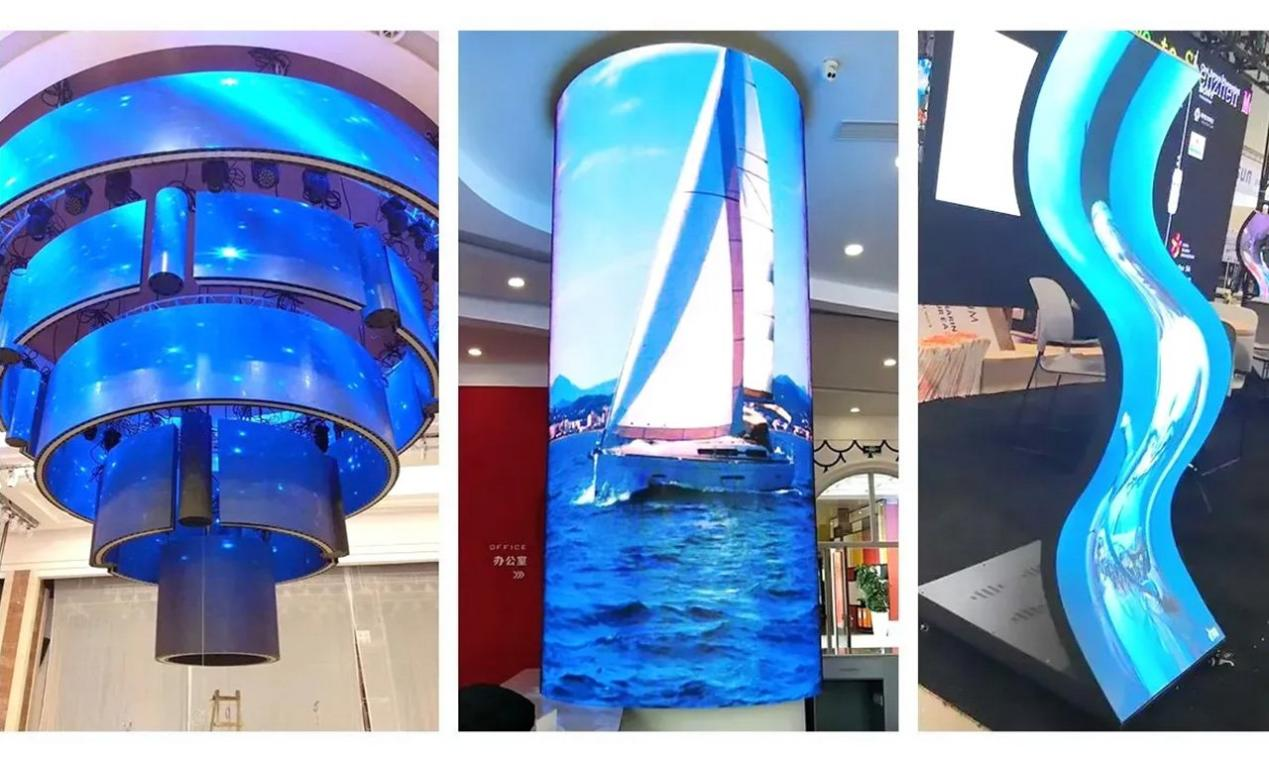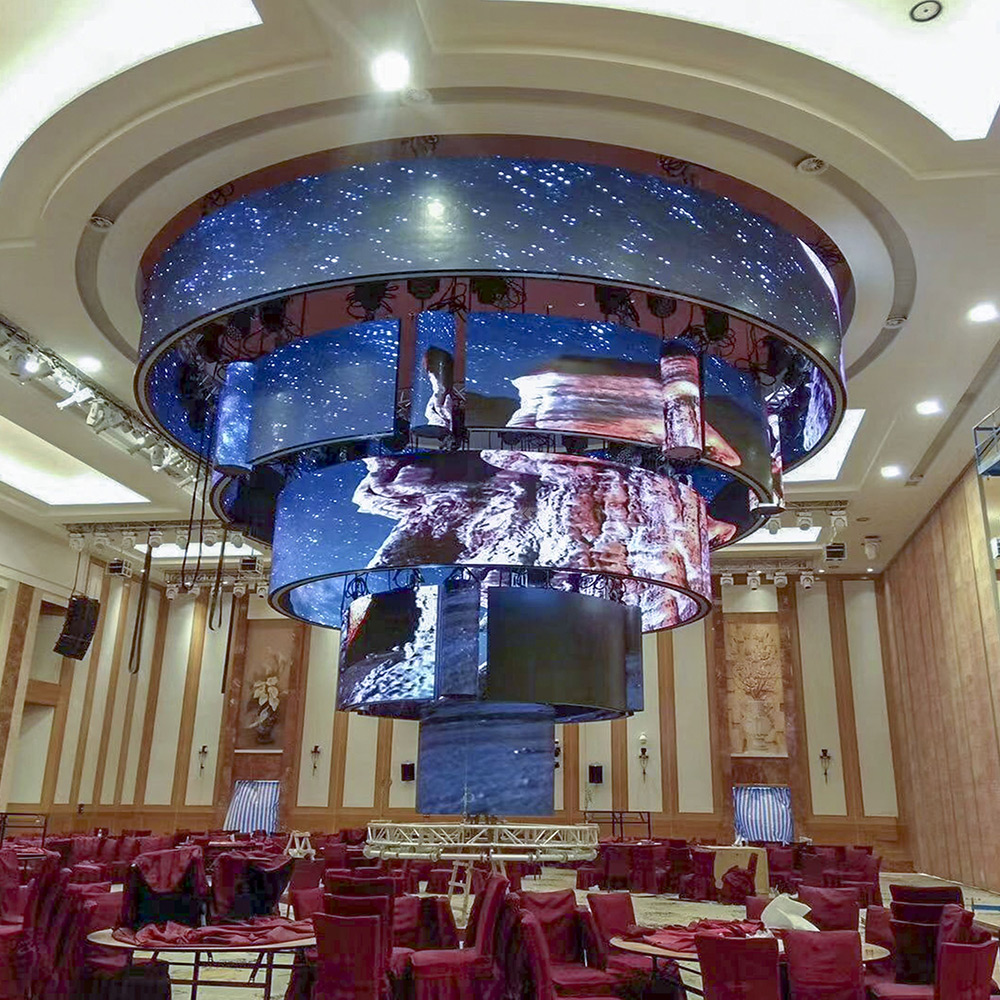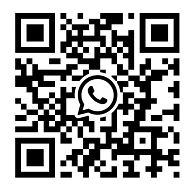In a world where architecture and digital media increasingly intersect, EnvisionScreen’s flexible LED display offers a practical and imaginative solution for projects that require displays to bend, curve, or wrap around unconventional structures. The Flexible LED Display (Flexible LED Screen) from EnvisionScreen is engineered for stages, retail, architectural façades, and immersive environments where a flat panel simply won’t do. This news release lays out the full LED display product customization plan, explains why customers choose EnvisionScreen, details application scenarios, explains how to commission a custom solution, enumerates core characteristics and features, and closes with a comprehensive Q&A.
Overview: What is the Flexible LED Display?

LED Display Product Customization Plan — Step-by-Step

Below is a practical, step-by-step roadmap for custom projects that need a flexible LED solution. This process is used widely across the industry and reflects EnvisionScreen’s own project flow.
1. Project Inquiry & Initial Brief
- Client provides a sketch or architectural drawing, approximate dimensions, target curvature (convex/concave, cylinder, partial dome), environmental constraints (indoor/outdoor, ambient light), desired pixel pitch (P1.25, P1.875, P2.5, P3, P4, etc.), content examples, and timeline. If available, provide CAD files or photos of the installation site.
- Key technical questions are: intended viewing distance, expected brightness (nits) for the environment, service access preference (front or rear maintenance), and power/cabling constraints.
2. Feasibility Study & Concept Proposal
- Engineering assesses bending radius limits (EnvisionScreen flexible modules support bending in typical ranges such as R100–R600 depending on module and pitch), structural mounting concepts (magnetic mounting, adsorption, custom skeleton), and thermal/power requirements. A conceptual solution with high-level BOM and timeline is provided.
3. 3D Renderings & Visual Mockups
- Photorealistic renderings and mockups visualize the curved LED surface in the client’s space, allowing content previews, daylight/lighting studies, and angle checks.
4. Detailed Engineering & BOM
- Drawings, module layout, cabling plan, power injection diagram, controller selection, and installation notes are produced. The Bill of Materials lists pixel modules, flexible PCB materials, magnets or fasteners, power supplies, LED controllers, and spare parts.
5. Prototype / Sample Production & Testing
- A sample curved strip or patch is manufactured and tested: bending endurance, brightness uniformity, color calibration, and thermal cycling. EnvisionScreen performs aging and bending tests (their materials are reported to pass many thousands of bending cycles in lab testing).
6. Production & Quality Control
- After prototype approval, full units are produced with rigorous QC — pixel tests, burn-in, color calibration, and waterproofing (if requested). Industry trend reports show that flexible and transparent LED products have seen broader adoption and more sophisticated QC processes in recent years.
7. Packaging & Logistics
- Modules are packaged with shock-proof materials and moisture protection for international shipment. Labels for cabling and module orientation are included.
8. Installation & Commissioning
- Onsite installation follows the approved drawings. EnvisionScreen provides installation videos, documentation, and can dispatch field engineers for supervision and calibration as required.
9. Training & Handover
- Client operators are trained on CMS (content management system), brightness calibration, routine maintenance, and spare module replacement.
10. After-sales Support & Warranty
EnvisionScreen supplies spare parts and warranty support; typical service life is specified up to 100,000 operating hours with standard warranty terms applied.
Why Clients Choose EnvisionScreen — Competitive Advantages
When you commission a custom curved or flexible LED solution, the choice of manufacturer matters. Clients choose EnvisionScreen for the following practical reasons
Key advantages
- ·Manufacturer control & R&D — EnvisionScreen is a producer with in-house R&D and manufacturing capability; this is crucial for custom materials and flexible PCB processes.
- ·Wide pixel pitch range — Flexible modules are offered in fine and standard pitches (P1.25 / P1.875 / P2 / P2.5 / P3 / P4), so you can pick the perfect balance of resolution and budget.
- ·Lightweight & ultra-thin modules — Simplifies structural loads on curved or floating surfaces.
- ·High refresh / high gray levels — Capable of smooth video (high refresh rates reported, e.g. ≥3840Hz–7680Hz depending on configuration), minimizing flicker in broadcast and live events.
- ·Modular & serviceable — Magnet-assisted or front-serviceable modules allow quick maintenance and individual module replacement.
- ·Creative freedom — Flexible LED makes possible cylinders, waves, ribbons, and free-form shapes — ideal for brand experiences, theater, and art installations. Industry shows and trade events underscore increasing demand for flexible and creative display forms.
- ·Turn-key capability — From design to calibration and training, EnvisionScreen provides one-stop service to minimize integration risk.
Application Scenarios — Where Flexible LED Displays Deliver the Most Value
Flexible LED displays are especially valuable wherever geometry is not flat and visual impact matters. Below are high-value use cases:
1. Stage Backgrounds & Performance Backdrops
Curved and ribbon displays allow event designers to wrap stage backdrops, create curved tunnels, and produce perspective illusions. The lightweight, modular structure simplifies transport for rental & touring use.
2. Retail Flagship Stores & Window Displays
Flexible LED film and curved displays convert glass façades or shop interior features into attention-grabbing media surfaces without blocking natural light (for transparent film variants). Such installations are proven to increase dwell time and conversion in retail settings.
3. Architectural Columns & Façade Wraps
Columns, round atria, and corner facades can be turned into dynamic brand canvases — perfect for hotels, malls, and corporate lobbies.
4. Museums & Immersive Exhibits
Curved LED walls and cylindrical displays create immersive storytelling spaces for exhibitions and interactive art.
5. Broadcast Studios & XR Stages
Flexible LED walls underpin virtual production and XR studios, enabling 270° wrap visuals for realistic virtual backgrounds and real-time content integration. Industry trade shows (ISE, etc.) have shown increasing interest in flexible solutions for studios.
6. Airport Terminals & Transit Hubs
Rounded columns and concave ceilings can host wayfinding, advertising, and content that responds to passenger flow.
7. Hospitality & Entertainment Venues
Hotel lobbies, casinos, and clubs use curved LED installations to present ambient visuals, promotions, and synchronized shows.
8. Theme Parks & Immersive Rides
Flexible LED tunnels and domes enable spectacular sensory environments that changе the guest experience.
These applications demonstrate how flexible LED screen technology unlocks creative design while remaining practical for maintenance and installation.
How to Commission a Custom Flexible LED Display from EnvisionScreen
If you want to start a project, follow this condensed process:
1.Contact EnvisionScreen (product page & contact) with your basic requirements.
2.Share drawings or photos (sketch, CAD, photos).
3.Select pixel pitch (P1.25–P4 have typical use cases: P1.25 / P1.875 for close-range indoor, P2.5–P4 for mid-to-longer viewing distances).
4.Approve design & prototype; place deposit to begin production.
5.Schedule delivery & installation; inspect prototype in person or via video.
6.Commissioning & training; finalize content handover.
7.Warranty & maintenance plan; plan for spare parts and future servicing.
Product Details & Technical Parameters (Representative)
Below are representative technical parameters taken from EnvisionScreen’s Flexible LED Display product page. These are typical module specs used to inform engineering decisions:
·Pixel pitch: P1.25 / P1.875 / P2 / P2.5 / P3 / P4
·Module size: 240 × 120mm/320x160mm× ~8.6 mm
·Lamp types: SMD1010 / SMD1515 / SMD2121 depending on pitch
·Module resolution: e.g., 192×96 (P1.25) , 128×64 (P1.875) etc.
·Pixel density: ranges from ~640,000 dots/sqm (P1.25) to ~62,500 dots/sqm (P4)
·Brightness: ~600–1000 cd/m² (indoor)
·Refresh rate: ≥3840Hz (some configurations up to 7680Hz)
·Gray scale: 14–16 bit
·Viewing angle: H:140°, V:140°
·Power consumption (module): Max ~45W / Avg ~15W per module (depending on configuration)
·Operating temperature range: −40°C to +60°C (module level rating)
·Operating life: Up to ~100,000 hours
·Maintenance: Front service (module replacement is front accessible)
·Bending radius: Typical bending range R100–R600 (depends on project & module)
Features & Advantages
Below is a Markdown-style features / advantages section you can copy directly into a blog or product news page.
Advantages & Features of EnvisionScreen Flexible LED Display
Flexible / Curvable Design — Bends to convex and concave geometries (typical bending range R100–R600).
Fine Pixel Pitch Options — Available P1.25, P1.875, P2, P2.5, P3, P4 for close-up clarity or long-range visibility.
Ultra Thin & Lightweight Modules — Slender modules (≈8–9 mm thick) ease installation on fragile or unusual surfaces.
High Refresh Rate & Gray Scale — High refresh (≥3840Hz) and 14–16 bit grayscale deliver smooth video and accurate color.
Front Maintenance & Modular Replacement — Modules are front-serviceable for rapid swap and minimal downtime.
Seamless Modular Splicing — Modules tile without visible seams for continuous imagery across curved arcs.
Robust Testing & Aging — Long life and long-term aging tests performed to ensure durability under repeated bending.
High Brightness & Uniformity — Designed to maintain consistent luminance even on curving surfaces.
Custom Shapes & Freeform Layouts — Cylinder, ribbon, wave, and complex freeform projects supported.
Efficient Power & Thermal Design — Thermal paths and smart power injection reduce hotspots and voltage drop.
Compatibility with LED Film & Transparent Displays — EnvisionScreen’s product line also includes LED film and transparent LED options for glass and window applications. These solutions complement flexible LED in retail and architectural scenarios.
Frequently Asked Questions (Practical Guide)
Q1 — What pixel pitch should I pick?
- For close-view indoor applications like retail windows or reception lobbies, choose P1.25–P2.5 for crisp images. For mid-distance viewing or large decorative façades, P3–P4 balances cost and performance. EnvisionScreen’s product page lists module options P1.25 through P4.
Q2 — How tight a curve can the flexible LED take?
- Typical bending ranges are quoted between R100–R600, but the actual minimum radius depends on the module pitch and assembly design. Always validate with a sample or prototype to ensure no stress on LEDs or connectors.
Q3 — Can I use flexible LED outdoors?
- There are outdoor variants and film/transparent variants with higher IP protection, but the standard indoor flexible module is primarily for indoor or semi-outdoor protected environments. Specify outdoor use early so the design includes weatherproofing.
Q4 — How is brightness managed on curved surfaces?
- EnvisionScreen uses factory calibration and brightness equalization algorithms plus power injection planning to ensure uniform luminance across curves. Onsite commissioning fine-tunes brightness and color.
Q5 — What are maintenance considerations?
- Modules are front-serviceable; magnet adjustments and modular swaps are typical. Keep spare modules on hand for mission-critical installations.
Q6 — Will flexible LED degrade faster than rigid LED?
- With proper material selection, bending constraints, and limited repeated flexing, long service life (tens of thousands of hours) is achievable. EnvisionScreen reports long-term aging and bending tests as part of QC.
Q7 — How long is lead time for custom projects?
- Lead times vary by complexity; prototype and testing add time. Typical production lead times for complex custom projects range from several weeks to months depending on scale and contract terms. Industry demand for flexible and transparent LED products has increased lead times in some regions due to rising adoption.
Market Context & Why Flexible LED is Trending

Several trends are driving demand for flexible and creative LED solutions:
- Retail & Brand Experience: Retailers want window and interior solutions that deliver brand storytelling without blocking sightlines. Transparent LED film and flexible screens are answering that need.
- Creative Event Design: Concerts and experiential events increasingly use curved tunnels, stage arcs, and tubular architectures that require flexible panels. Trade events like ISE 2025 showcased multiple flexible LED innovations.
- Technological Maturation: Improvements in flexible PCB materials, driver ICs, and production tolerances allow finer pixel pitches and higher refresh rates on bendable substrates. Industry analysts project continued market growth for novel display categories (mini / micro / transparent / flexible).
These market dynamics explain why brands and integrators prioritize flexible LED in new builds and renovations.
Example Project: Hospitality Lobby Curved Feature Wall (Sample Workflow)

Project brief: 8 m × 3 m curved wall behind the reception desk, curvature radius ~6 m, indoor, close viewing distance, P2.5 pixel pitch.
Workflow:
1.Client shares CAD drawing and photos.
2.EnvisionScreen proposes module layout (240 × 120 mm modules), renderings, and sample prototypes.
3.Sample strip delivered for on-site preview; client approves color and bending performance.
4.Full production, delivery, and onsite installation are scheduled; modules are magnet-aligned to the curved back frame.
5.Commissioning includes uniformity correction, content upload (ambient motion, signature visuals), and operator training.
6.Handover with spare parts and maintenance documentation.
Outcome: Seamless curved LED surface behind reception, continuous motion content that responds to guest flow and creates an upscale brand environment.
Installation Best Practices & Common Pitfalls
Best practices:
- Prototype early: Always produce and test a sample patch to confirm color, brightness, and bending radius.
- Plan mounting structure: The support frame (back skeleton) must match the planned curvature and allow for module tolerance and thermal expansion.
- Power injection strategy: Plan multiple power injection points to avoid voltage drop across long modules.
- Thermal management: Even thin modules require conductive thermal paths; consider airflow and heat sinking where modules are packed tightly.
- Use correct adhesives / magnets: For glass or delicate surfaces, vacuum adsorption or magnet-based mounting often outperforms simple tape. Industry guidance warns against inadequate adhesive methods for curved glass installations.
Pitfalls to avoid:
- Underestimating curvature stress: Very tight radii can stress LEDs and connectors. Validate with prototype.
- Poor power planning: Single point power injection causes uneven brightness and color shifts.
- Inadequate shipping protection: Flexible modules must be shipped with humidity control and shock-absorbent packing.
- Skipping field calibration: Without onsite calibration, color/brightness may vary across the surface.

Conclusion
In an age where creativity meets technology, the Flexible LED Screen stands as a true game-changer — redefining how we shape and display visual content. At EnvisionScreen, we believe flexibility isn’t just about the screen’s design; it’s about empowering your imagination to bend, curve, and flow freely with your message.
From curved architectural installations to dynamic stage backdrops and retail showcases, our flexible LED displays transform ordinary spaces into extraordinary experiences. Engineered for performance, durability, and seamless integration, every panel embodies our commitment to precision craftsmanship and cutting-edge visual technology.
As the world continues to evolve, so should your display solutions. With EnvisionScreen Flexible LED Screens, you’re not just adapting to the future — you’re shaping it.
Discover more about our latest flexible LED innovations at www.envisionscreen.com and see how EnvisionScreen brings your vision to life — in every curve, every light, and every pixel.
Post time: Oct-28-2025



